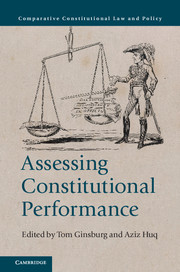Book contents
- Frontmatter
- Contents
- List of figures
- List of tables
- List of contributors
- Acknowledgments
- INTRODUCTION
- PART I DEFINING CONSTITUTIONAL PERFORMANCE
- PART II MANAGING SPECIFIC CONSTITUTIONAL CHALLENGES
- 6 Constitutional performance in transitions from military to civilian rule
- 7 Constitutional permissiveness, constitutional restrictiveness, and religious freedom
- 8 Performance of constitutions: Transitional provisions
- 9 Time and constitutional efficacy
- 10 Competitive democracy and the constitutional minimum core
- PART III CASE STUDIES
- Index
- References
9 - Time and constitutional efficacy
from PART II - MANAGING SPECIFIC CONSTITUTIONAL CHALLENGES
Published online by Cambridge University Press: 05 August 2016
- Frontmatter
- Contents
- List of figures
- List of tables
- List of contributors
- Acknowledgments
- INTRODUCTION
- PART I DEFINING CONSTITUTIONAL PERFORMANCE
- PART II MANAGING SPECIFIC CONSTITUTIONAL CHALLENGES
- 6 Constitutional performance in transitions from military to civilian rule
- 7 Constitutional permissiveness, constitutional restrictiveness, and religious freedom
- 8 Performance of constitutions: Transitional provisions
- 9 Time and constitutional efficacy
- 10 Competitive democracy and the constitutional minimum core
- PART III CASE STUDIES
- Index
- References
Summary
A standard way to think about constitutional efficacy is to compare the text of a document with reality, as captured in some empirical measure. In our experience, it is an extremely rare conversation about comparative constitutions that is not interrupted by a plaintive interjection – by well-meaning observers – that constitutional rules are not always enforced. While commentators no doubt intend such remarks as a caution against excessive formalism, we find these interjections tiresome and sometimes wish they were deterred by cruel and unusual punishment. Too harsh? Perhaps, but the interjection misunderstands the appeal of constitutions entirely. The surprising fact is not that constitutions are often ignored; it is that they guide the behavior of power-hungry leaders at all! Indeed, the holy grail of constitutional scholarship is the identification of those conditions that lead leaders to adhere to their prior commitments (and to those of their forbears). In this chapter, we reconsider an important condition that is central to constitutionalism: time.
Our chapter makes the observation that efficacy changes over time: Constitutional provisions can be either more or less effective over time (or the effect can be constant). In thinking about the criteria for constitutional success, it seems useful to consider whether there are general trends in efficacy over time, and whether certain provisions are more vulnerable than others to decay and desuetude. Using rights as a focus, this chapter undertakes that inquiry.
We have grappled with this question previously, mostly in an effort to speak to the normative implications of long-lived constitutions (Elkins et al. 2009) and, then, mostly in passing. Our return to the question arises in the context of our current investigation into the origins, spread, and consequences of constitutional rights. Our empirical approach, therefore, is myopically rights-centric. To be specific, our research question is, do constitutional rights become more or less effective as they age?
To emphasize our focus on rights, and since the analysis of institutional effects can be maddeningly aggregate and abstract, consider the right to health in Kenya and South Africa. Kenya entrenched the right to health when it rewrote its constitution in 2010 (Article 43). South Africa incorporated a right to health in its 1996 post-apartheid constitution (Article 27). Neither country had a right to health in its prior constitution.
- Type
- Chapter
- Information
- Assessing Constitutional Performance , pp. 233 - 267Publisher: Cambridge University PressPrint publication year: 2016
References
- 4
- Cited by



